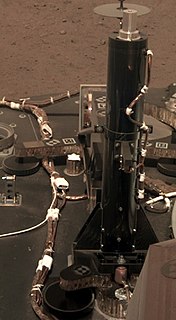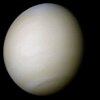
Observations of the planet Venus include those in antiquity, telescopic observations, and from visiting spacecraft. Spacecraft have performed various flybys, orbits, and landings on Venus, including balloon probes that floated in the atmosphere of Venus. Study of the planet is aided by its relatively close proximity to the Earth, compared to other planets, but the surface of Venus is obscured by an atmosphere opaque to visible light.

Venera-D is a proposed Russian space mission to Venus that would include an orbiter and a lander to be launched in 2026 or 2031. The orbiter's prime objective is to perform radar remote-sensing observations with the use of a powerful radar. A lander, based on the Venera design, is also planned, capable of operating for a long duration on the planet's surface.

The Venus In Situ Explorer (VISE) has been a lander mission concept proposed since 2003 by the Planetary Science Decadal Survey as a space probe designed to answer fundamental scientific questions by landing and performing experiments on Venus.
Hayabusa Mk2 was a proposed Japan Aerospace Exploration Agency (JAXA) space mission aimed at visiting a small primitive asteroid and returning a sample to Earth for laboratory analysis. It was intended to be the follow-on mission to JAXA's Hayabusa mission, as well as the Hayabusa 2 mission. The latest proposal for Hayabusa Mk2 stated its target to be the dormant comet 4015 Wilson–Harrington, with a launch of the probe in 2018. From 2007 to 2010, it was also considered as a joint JAXA-ESA mission under the name Marco Polo. The in-situ investigation and sample analysis would allow scientists to improve our knowledge of the physical and chemical properties of a small Near-Earth Object (NEO) which is thought to have kept the original composition of the solar nebula in which planet formed. Thus, it would provide some constraints to the models of planet formation and some information on how life may have been brought to Earth. Information on the physical structure will help defining efficient mitigation strategies against a potential threatening object.
Journey to Enceladus and Titan (JET) is an astrobiology mission concept to assess the habitability potential of Enceladus and Titan, moons of Saturn.
Shukrayaan-1 is a proposed orbiter to Venus by the Indian Space Research Organisation (ISRO) to study the surface and atmosphere of Venus.
OKEANOS is a proposed mission concept to Trojan asteroids, which share Jupiter's orbit, using a hybrid solar sail for propulsion; the sail is covered with thin solar panels to power an ion engine. In-situ analysis of the collected samples would be performed by either direct contact or using a lander carrying a high-resolution mass spectrometer. A sample-return to Earth is an option under study.

VERITAS is a proposed mission concept by NASA's Jet Propulsion Laboratory (JPL) to map with high resolution the surface of planet Venus. The combination of surface topography and image data would provide knowledge of Venus' tectonic and impact history, the timing and mechanisms of volcanic resurfacing, and the mantle processes responsible for them.

DAVINCI is a proposed mission concept for an atmospheric probe to Venus. It lost out to Psyche and Lucy in the 2015 round of proposals for NASA's Discovery Program. It will be proposed again on 1 July 2019.
The ExoMars Kazachok is a planned robotic Mars lander led by the Roscosmos, part of the ExoMars 2020 mission by the Roscosmos and the European Space Agency. Kazachok translates as "Little Cossack", and is also the name of a Russian folk dance.

SPRITE was a proposed Saturn atmospheric probe mission concept. SPRITE is a design for an atmospheric entry probe that would travel to Saturn from Earth on its own cruise stage, then enter the atmosphere of Saturn, and descend taking measurements in situ.

Venus In situ Composition Investigations (VICI) is a concept lander mission to Venus in order to answer long-standing questions about its origins and evolution, and provide new insights needed to understand terrestrial planet formation, evolution, and habitability.
Venus Origins Explorer (VOX) is a concept orbiter mission to Venus.
The Enceladus Icy Jet Analyzer (ENIJA) is a time-of-flight mass spectrometer developed to search for prebiotic molecules like amino acids and biosignatures in the plumes of Saturn's moon Enceladus.

EnVision is a proposed orbital mission to Venus that would perform high-resolution radar mapping and atmospheric studies. The mission would help scientists understand the relationships between its geological activity and the atmosphere, and it would investigate why Venus and Earth took such different evolutionary paths. The mission is studied in collaboration with NASA, with the potential sharing of responsibilities currently under assessment.

The Heat Flow and Physical Properties Package (HP3) is a science instrument onboard the InSight lander that features a self-penetrating probe to determine how heat flows inside Mars. InSight landed on Mars on 26 November 2018. In March 2019, it successfully burrowed a short distance into Mars subsurface, but encountered resistance.
Mars Multispectral Imager for Subsurface Studies (MA-MISS) is a miniaturized imaging spectrometer designed to provide imaging and spectra by reflectance in the near-infrared (NIR) wavelength region and determine the mineral composition and stratigraphy. The instrument is part of the science payload onboard the European Rosalind Franklin rover, tasked to search for biosignatures, and scheduled to land on Mars in 2021. MA-MISS is essentially inside a drill on the Rover, and will take measurements of the sub-surface directly.
Nadir and Occultation for MArs Discovery (NOMAD) is a 3-channel spectrometer on board the ExoMars Trace Gas Orbiter (TGO) launched to Mars orbit on 14 March 2016.

















